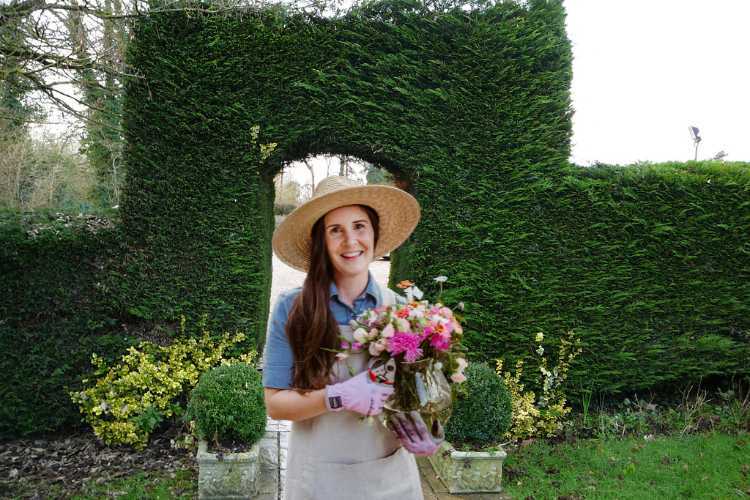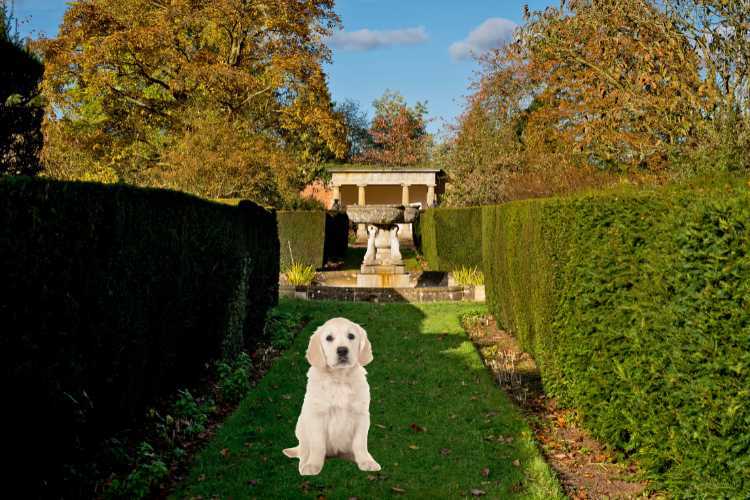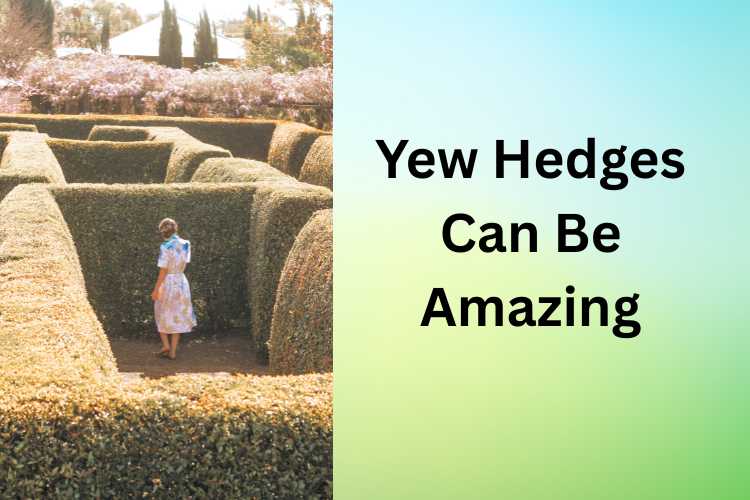How to Grow an English Yew Hedge
6th Apr 2025
Yew is the type of hedge you see in formal gardens. But you don’t have to be the lord of the manor to plant an English yew hedge in your garden; it’ll look just as good at your home as it would in a park setting. In fact, English yew (Taxus baccata) has long been popular with gardeners, and is prized for its dense evergreen foliage which gives all year-round interest and of course that classic appearance.
English yews are slow-growing, evergreen conifers that can live for more than a lifetime when properly cared for. They are known for their tolerance of pruning, which makes them particularly well-suited for shaping into formal hedges. However, the slow growth rate means that while yews are hardy and will withstand anything the British weather can throw at it, you’ll need plenty of patience during the early years while the hedge matures and becomes established.

Ideal Garden Settings
Of course, English yew hedges are very popular in gardens that want a classic, structured look. But there are several settings in which they look the business:
- Formal Gardens: Providing a neat, architectural line in traditional designs.
- Mixed Borders: Yes, can be a really nice backdrop to colourful perennials and annuals.
- Privacy Screens: Their dense growth provides really good screening from neighbours and busy streets.
- Historic Gardens: Many of us will have seen English yew hedges in the gardens of stately homes.
All in all, the yew’s ability to thrive in a variety of soil types—provided there is good drainage—and its tolerance for partial shade make it adaptable to many garden settings, although some conditions can pose challenges.
English Yew Hedge Pros and Cons
There are two sides to every argument so let’s look at the pros and cons of choosing to plant a yew hedge.
Pros
Dense, Evergreen Privacy Screen
English yew hedges provide a year-round barrier that not only looks great but also provides privacy. Their thick foliage creates a natural screen which will also help reduce noise and wind.
Timeless Looks
The classic, dark green appearance of the yew just looks so good. When the hedge is pruned carefully, it can be shaped into different shapes and forms and will add a real touch of class to your garden.
Longevity and Durability
With proper care, English yews can live for centuries. Their slow growth rate is balanced by their robust nature and resilience, particularly when they are well-established.
Tolerance for Pruning
Yews respond well to pruning, and you can certainly get creative with the shears. Regular trimming can encourage a denser growth habit to keep the desired shape and size, making them ideal for structured garden designs.
Cons
Toxicity Concerns
One of the biggest drawbacks is the yew’s toxicity. Almost every part of the yew plant, except the fleshy red arils (berries), is toxic if ingested. This could be a significant concern if you have small children or pets.
Specific Soil and Light Requirements
While yews are versatile and hardy, they do best in well-drained soils. Heavy clay soils can retain too much moisture, leading to root rot. Also, although yews tolerate partial shade, they generally perform best when they receive a mix of sun and light shade.
Slow Growth and Establishment Time
The slow-growing nature of yews means that it can take several years for the hedge to become fully established. It’s not an instant solution like a leylandii hedge. You do need to be patient when growing yew.
High Maintenance
With yew you can’t plant and forget. Maintaining the hedge’s shape and density needs regular pruning and care. Although they are relatively low-maintenance once established, the early years demand careful attention to ensure that the hedge develops a strong structure.

How to Grow an English Yew Hedge: Step-by-Step Guide
Let’s have a look at how to plant and grow your new yew hedging plants.
Planning & Preparation
Choosing the Right Location
When thinking about where to plant yew, consider:
- Sunlight: Although yews tolerate partial shade, they perform best with a balance of sun and shade. A spot that receives morning sun and afternoon shade can be ideal.
- Soil Quality: Yews prefer well-drained soil. But you can improve poor soil with organic matter or grit to improve drainage.
- Space: Plan for the mature width and height of the hedge. Although yews can be pruned to maintain a compact form, they still require adequate space for their roots.
Preparing the Soil
Before planting, prepare the soil:
- Clear the Area: Remove any weeds, stones, and old plant material.
- Improve the Soil: Mix in compost or well-rotted manure.
Plant Your Hedge
Best Time to Plant
The best time to plant English yews is during the autumn or early spring. This planting allows the hedge to establish roots during the cooler, wetter months.
Spacing and Planting Techniques
If you want a dense hedge, and who doesn’t, make sure you think about spacing:
- Spacing: Generally, plant yews at a distance of 45-60cm apart, depending on the desired density and eventual hedge width.
- Planting Hole: Dig a hole twice as wide and the same depth as the root ball. This encourages roots to spread into the surrounding soil.
- Positioning: Gently remove the yew from its container, loosen the roots slightly, and position the plant in the centre of the hole. Ensure the top of the root ball is level with the ground surface.
- Backfilling: Fill the hole gently firming the soil around the roots to eliminate air pockets.
- Watering: After planting, water thoroughly to help settle the soil and support the roots.
Ongoing Care & Maintenance
Watering and Feeding
- Watering: Newly planted yews need regular watering, especially during dry spells. Once established, they are relatively drought-tolerant, but during prolonged dry periods, an occasional deep watering can help.
- Feeding: Apply a balanced, slow-release fertilizer in early spring to support new growth. Organic options such as well-composted manure can also be beneficial.
Pruning and Shaping
- Initial Pruning: Start pruning when the hedge has established enough new growth, usually after the first growing season. Early pruning encourages lateral growth, which is the first step to a dense hedge.
- Regular Maintenance: Aim to trim the hedge at least once a year, typically in late spring or early summer. Avoid heavy pruning in late summer or autumn, as this can stimulate new growth that may not harden off before winter.
- Tools: Use clean, sharp hedge shears or secateurs to make precise cuts. Disinfect your tools between cuts to prevent the spread of diseases.
Disease and Pest Control
While English yews are generally hardy, they can occasionally face challenges:
- Pests: Common pests include scale insects and aphids. Regularly inspect your hedge and, if necessary, use horticultural oils or insecticidal soaps to manage infestations.
- Diseases: Yews are susceptible to root rot if planted in poorly draining soils. Remove any affected branches promptly and consider using a fungicide if needed.
Troubleshooting
- Poor Establishment: If your yew hedge appears to be struggling in its early stages, check for issues such as waterlogging, nutrient deficiencies, or inadequate sunlight.
- Sparse Growth: In areas where the hedge seems thin, add fertiliser or some additional pruning. This should stimulate bushier growth.
Additional Tips
- Autumn Planting: Planting in autumn allows your yews to benefit from the winter rains and cooler temperatures. This helps the roots become established before the growing season.
- Spring Maintenance: Early Spring is the best time to carry out pruning and to feed your hedge, this will help promote growth.
- Winter Care: Although yews are hardy, protecting young plants from severe frost or unexpected cold snaps is wise. Consider using horticultural fleece or other protective materials on young hedging plants during unusually harsh winters.
- Underplanting: Consider planting shade-tolerant ground covers or perennials at the base of your yew hedge. This not only looks nice but can also help retain soil moisture.
- Mixed Borders: English yews work well as a backdrop for more colourful flowering shrubs and perennials. Their deep green foliage is a nice contrast to the bright blooms of other plants.
- Biodiversity: While yews themselves are not particularly attractive to pollinators, combining them with pollinator-friendly plants can encourage a healthy garden ecosystem.
Why You Should Choose Yew
Why wouldn’t you want a lovely yew hedge in your garden? It will bring a nice formal look to your garden and it is so dense it is a perfect privacy screen.
Frequently Asked Questions (FAQs)
Q1: How long does it take for an English yew hedge to mature?
A: English yews are slow-growing plants. Typically, you can expect your hedge to take several years to become dense and well-established. While you might notice initial growth within the first year, achieving the full, mature appearance could take anywhere from 5 to 10 years or more depending on growing conditions and pruning.
Q2: Can I prune my yew hedge throughout the year?
A: Pruning is best done during the growing season—preferably in late spring or early summer. Avoid heavy pruning in late summer or autumn, as new growth stimulated during these times may not harden off before winter, potentially leading to damage.
Q3: Are there any specific soil conditions that English yews prefer?
A: Yes, yews thrive in well-drained soils with a slightly acidic to neutral pH (around 6.0 to 7.0). In areas with heavy clay soils, it can help to work the soil with organic matter or sand to improve drainage and support healthy root development.
Q4: How do I handle pest and disease issues in my yew hedge?
A: Make sure you regularly inspect your hedge during the growing season. Ensure good drainage to prevent fungal issues, and remove any affected branches promptly.
Check out all our hedging plants or for more information on choosing the right hedge for you read our hedging buyers guide.


